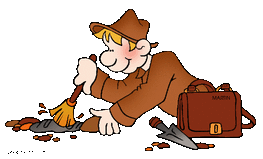Developing your own gear kit from scratch can be intimidating, but this guide is meant to give you a starting point to think about what you need. It is based heavily on my own experiences. The "basics" and "necessities" are the things I had during my earliest archaeology experiences, when I was pretty clueless and leaned heavily on coworkers. Since then, I have gradually expanded my gear collection. Start with what you can afford, and build on it from there.
Keep in mind that this list is very subjective. A lot will depend on where you work, who you work for, and what you do. Survey and excavation, for example, require different things. Also note that if you are
doing your first field school or an internship, a lot of things may be provided for you.
Also, don't forget to label your gear. Use a sharpie to write your initials on all your stuff, and touch it up as it fades. In the field, things are frequently borrowed, passed around, and mixed up- your gear is an investment, and you don't want to lose track of it.
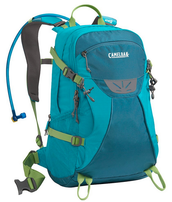 Camelbak Trinity
Camelbak Trinity - A Good Backpack. Comfort and capacity are all important. Make sure you get one that fits comfortably, and keep in mind how much you will need to carry. Personally, I have two. I have a smaller 600 cubic inch capacity High Sierra bag for days I don't need to carry much. It's too narrow to fit a clipboard, but it's nice for quick, low acerage surveys or excursions where I am using a field notebook rather than a clipboard. I also have a Camelbak Trinity that, at 1525 cubic inches, is much larger and perfect for days when I'm carrying a lot of gear. Backpacks with hydration bladders are a great option for making sure you drink enough in the field. Finally, I'll leave you with two other things to consider: color and straps. I work in tall grass, so a brightly colored bag is nice when I set my bag down and wander away. I also like the option to attach things to my bag, so I look for gear with numerous attachment points.
- Boots. Again, comfort is key. You will be on your feet for long hours, so good footwear is not the place to cut corners. Keep in mind that boots often need to be broken in. If you are buying gear for a field school, plan ahead and make sure you aren't wearing your new boots for the first time on your first day in the field.
- Proper Field Clothing. The comfort theme continues with field clothing, but achieving that comfort often requires some balance. For example, I work in the desert. I am always on the hunt for clothing that is light and breathable in the heat, but not so thin that thorny shrubs will shred it after a week. Keep weather, vegetation, terrain, and temperature in mind. Also, don't forget about safety. If you work in an area where you may encounter hunters, make sure you have a bright vest! Field clothing deserves it's own post, so stay tuned for more!
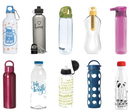
- Water bottles. Yes, thats water bottles plural. Dehydration will ruin your field experience, so bring as much water/gatorade/whatever as you think you'll need and then add a little more. I typically use a hydration bladder and then bring a water bottle or two in addition. Reusable bottles like Nalgene's are preferred. Also, if you're like me and can't drink from a wide-mouth bottle without pouring water all over yourself, they sell splashguards. You're welcome.
- Pills & Medications. I carry a small container with a few painkillers and over the counter allergy pills. I also bring an inhaler for my mild asthma. Remember, if you have any medical conditions always tell your field director and colleagues- if something happens in the field, they can't help you if they don't know whats wrong!
- Basic First Aid. Your field school or project should have a fully equipped first aid kit on hand, but it never hurts to have a few bandaids tucked away in your gear.
- Hand wipes. Individually wrapped wet wipes will be your best friend when it's time to eat lunch and your hands are brown with caked on dirt.
- A Measuring Tape. Taking measurements is a nearly constant activity in the field, and nobody likes the person who is always borrowing everyone else's tape. Trust me, I used to be that person. Keep in mind what units of measurement you will need. If you are doing historic archaeology in the U.S., feet and inches will suffice. For anything else, meters and centimeters are a must.
- A Field Notebook. Write down everything you do. You never know when you will need to look back and double check a date, location, or artifact number. There are all kinds of dirt-proof, water-proof, super-magically-durable notebooks designed especially for the outdoors, but theres no need to get fancy. As long as it has a hard cover and is a size that you can comfortably hold and write in it will do the job.
- A Clip Board. If you aren't writing in your notebook, you're probably filling out field forms on a clipboard. They come in all sorts of varieties, but the most important thing is to get one that has an internal compartment. Carrying extra forms inside of your clipboard is a must, and will make your life much easier.
- Pens & Sharpies. This one is a no brainer, but Sharpies deserve emphasizing. I don't know about other archaeologists, but I have frequently found myself in the need of a Sharpie in the field, and lo and behold no one has one.
- A Compass. Whether you are surveying, navigating, or taking notes on your surroundings you need to know what direction things are located in. In a pinch, look for the compass feature on your iPhone. It's not as accurate as the real deal, but if you're doing something that doesn't require a high degree of precision (like noting what direction a field photo was taken in), it'll do the trick.
- Comfort Items. Think about the environment you are going to be working in. Is it hot? Then don't forget sunglasses and sunscreen. Humid and buggy? Don't get caught without your rain poncho and insect repellant.
- Snacks. Theres nothing worse than a rumbling stomach during field work. Depending on what kind of work you're doing you may have a bagged lunch, but it's always nice to have a granola bar stashed away in your bag when theres an hour left until lunch and you just cant wait. Field work can also be very physically demanding. You often burn through more calories than you anticipate and feeling dizzy and weak is no fun.
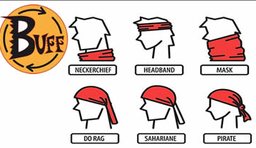
- A Buff. Buffs are basically fabric tubes that you can wear around your neck in a number of configurations. They come in fun patterns as well as different fabric types (UV protection, anyone?). I love them for two reasons. First, they provide great sun protection for your often-vulnerable neck. Second, you can pull them up over your nose and mouth to avoid getting a lung full of dust on windy days. Alternatively, bandanas are a cheaper option.
- Carabiners. I love carabiners. I buy them in 3 packs and leave them clipped all over my field bag. In the field, you never know when you are going to need to attach one thing to another thing. Sometimes you find yourself facing a long hike, and thats never fun with your hands full. I'll use them to hook water bottles, my lunch box, and other gear on the exterior of my backpack.
- Flagging Tape/Pin Flags. This is probably something that your field school or office buys in bulk, but its great to have. Pin flags are great for marking artifacts on the ground, while flagging tape can be tied onto just about anything that needs to stand out.
- A Flag Bag. Heres a secret I learned from one of my awesome archaeology friends- you know those nylon drawstring bags that camping chairs come in? They happen to fit pin flags perfectly, and they have a strap so you can wear them over your shoulder. If surveying with a handful of pin flags has gotten old, try out a flag bag to keep them compact and organized.
- A Rubberband. Do you work somewhere windy? Then you've probably dealt with field forms flapping around on your clipboard while you try to write. Larger, thicker rubber bands are great to wrap around your clipboard to hold the loose end of your forms in place.
- A Fold Out Ruler. While a basic measuring tape will accomplish most of what you need, there are times you'll want a stiff, fold out ruler such as a Lufkin. Sometimes, a wiggly, bendy tape doesn't quite do the trick, and it can be nice to have another option.
- A Jewelers Loop. I don't know about you guys, but my vision is terrible. Sometimes you find yourself passing a cartridge around in the field, all eyes straining to read the head stamp to determine if it's '46 or a '48. Your eyes can use a little help sometimes, and a jewelers loop is an easy, compact way to do that.
- Photo Scales and/or a North Arrow. Sure, you can say what direction a photo was taken in the caption, or use your measuring tape as a scale in a artifact photo. However, it looks a heck of a lot more professional with a real photo scale or north arrow.
- Smartphone. You can do just about anything with a smartphone these days, and they can be super helpful in the field. They can be makeshift compasses or GPSs, backup field cameras, and a way to communicate with your crew. They're also fun- I love taking personal pictures in the field and texting artifact photos to archaeologist friends who I know will get a kick out of them. Get a heavy duty phone case like an Otter Box to make sure it's protected.
- Knife. Truth be told, I've actually never used my knife in the field. However, preparation is key to a good archaeology gear kit, and I always strive to avoid those "Oh no, if only we had a ______!" moments. Small pocket knives take up very little space and can be infinitely useful, so it's worth including in your kit.
- Gloves. Once again, how badly you need gloves depends on what you're doing. They're a must for excavation, but not as necessary if you're surveying.
- Trowels. I'm amazed I made it this far down the list without mentioning the most iconic archaeology tool! Like many of the other things mentioned here, they're vital for excavation, but less necessary on a day to day basis. However, they're always good to have on hand in case you need to pop something out of the ground. Marshalltown and WHS trowels each seem to have their own fan club, and as you accumulate trowels you'll develop your own preferences.
- Artifact Bags. I always keep at least a few with me. Even if you have no plans to be collecting artifacts, you never know when you'll stumble across something that needs to be collected.
- Tooth Brush. These are great for doing a quick-and-dirty artifact cleaning in the field. If you need to examine something in more detail but it is caked in dirt, your basic household toothbrush will suddenly be your best friend.
- Line Level, String, Spikes. These 3 things are vital to any excavation. You cannot set up a unit without them. Additionally, as you excavate your unit, a dust brush and pan will help you keep it neat, clean, and ready for photographs.
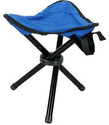
- A Mini Camp Chair. This is definitely a luxury, and it's probably not something you want to carry if you're hiking in to a site. However, if you find yourself spending hours filling out forms or drawing features, you're going to be a lot more comfortable on a mini camp chair than on the ground or a inverted bucket. These things have been growing cheaper and smaller over the years, so it's not a bad thing to invest in.
- Munsell Soil Color Charts. These are an archaeological standard, but they can also be incredibly expensive. Personally, I do not own Munsell soil color charts and I've gotten by just fine.
- Kneepads. Kneepads are definitely not necessary, but if you have knee problems after a long day kneeling alongside a unit they may be worth picking up. They are generally cheap, lightweight, and can help increase your comfort!
- A Snake Stick. I included this in the "luxuries" category because a snake stick probably isn't necessary in your own personal gear kit. However, if you work somewhere with snakes, your field school/office/etc. should have one. If relocating the humans is not an option, then relocating the snake is your next best bet, and it's great to have a way to do it safely so that no one- snake included!- gets hurt.
- Gaiters. To some, gaiters are a great way to protect your ankles and calves from snakes. To others, they are expensive, uncomfortable, and unnecessary. Personally, I have lived in rattlesnake territory my whole life and have never worried about it. The vast majority of the time, awareness and caution will be more than enough to keep you safe. However, if you have a fear of snakes, gaiters might be worth it to save yourself some anxiety.
- Amazon. Yup, good old Amazon. They truly have just about everything, and for the basics on this list (clipboards, water bottles, etc.) there is no need to pay a markup at a specialized outdoor retailer.
- Forestry Suppliers. A favorite among foresters, biologists, and pretty much all field professions, Forestry Suppliers will have a good deal of what is listed here.
- The Clymb. The Clymb is a daily-sale site geared toward outdoor enthusiasts. Their sales range from fasion/lifestyle goods to true outdoor gear, so keep an eye out for sales that are relevant to you. I bought my field backpack through them and got a great deal!
- Sierra Trading Post. Sierra Trading Post has awesome bargains on outdoor gear and apparel. Be sure to sign up for their mailing list- they send out coupon codes and promotions all the time.
